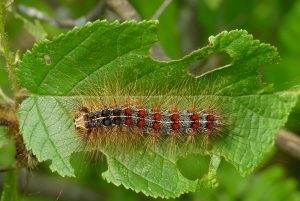
Gypsy moth caterpillar with distinctive blue and red dots
This June, gypsy moth populations may rise to damaging levels in parts of Wisconsin. High numbers of gypsy moth caterpillars are a tremendous nuisance and can strip trees of their leaves. Combined with other stresses, such as drought or attacks by additional tree pests, this may kill the tree. The insect’s favorite food is oak leaves, but it will feed on many other tree species such as aspen, birch, crabapple and willow. You can take action to reduce the number of caterpillars that will feed on your trees, including placing sticky barrier bands on the susceptible tree species.
Instructions for sticky barrier bands: The bands will prevent crawling caterpillars from climbing into your trees. At a convenient height, wrap a belt of duct tape 4-6 inches wide around each tree trunk, shiny side out. Smear the center of the band with a sticky, horticultural pest barrier available at garden centers. Every afternoon, brush the caterpillars below the duct tape into a can of soapy water to drown them.
Instructions for burlap bands: Caterpillars already in the tree will begin to grow and by early June the caterpillars will be about 1″ long in the southern half of Wisconsin (mid-June in the northern half). At this point, many of them will begin a daily migration down the tree in order to hide from predators. You can take advantage of this behavior by giving them a band of burlap to hide under – then destroy them. In early June, cut a piece of burlap 12″ to 18″ wide and long enough to wrap completely around the tree at chest height. Tie a piece of string around the middle of the burlap and fold the upper portion down to form a “skirt” around the tree. Every afternoon, check under the burlap and either cut the caterpillars in half or brush them into a bucket of soapy water to kill them. Prepare new sticky barriers and burlap bands every year, and remove them in August once the caterpillars are gone.
Insecticide options: When very large numbers of caterpillars are present, you may choose to spray your trees with an insecticide before the caterpillars can become a nuisance or strip the tree’s leaves. Although DNR’s Suppression Program spraying is complete already for 2017, this may be an option for high value yard trees yet this year. Bacterial insecticides must be applied while the caterpillars are less than 1/2″ long, whereas chemical insecticides may be applied at any time caterpillars are present. Be sure to follow the instructions found on the insecticide container. If you choose to hire a pesticide applicator, you can find certified arborists in the local area by searching the Wisconsin Arborist Association website. Also look in the phone book under ‘Tree Service’ because some businesses offering tree spraying are not listed on the WAA web site.
Next’s years Suppression Program: If you see large numbers of the caterpillars in your trees this summer and would like your property or neighborhood included in the 2018 Suppression Program spraying, contact your community’s Forestry or Public Works Department to report the gypsy moth infestation and request that the community participate in the Suppression Program. A directory of local gypsy moth contacts can be found online from the Wisconsin gypsy moth website. Woodlot owners can contact the County Coordinator directly in most cases.
Information on gypsy moth management is available by visiting the Wisconsin gypsy moth website. Homeowners seeking assistance can also call the DNR gypsy moth information line, 1-800-642-6684 (MOTH).
Written by: Bill McNee, Forest Health Specialist, Plymouth (Bill.McNee@Wisconsin.gov, 920-893-8543).
